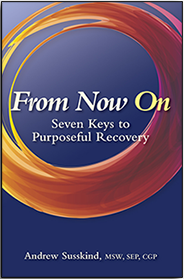Knowing where you end and the other person begins.
In Part 1 we were building awareness and insight regarding better boundaries. Sometimes, boundaries can go too far and become rigid and isolating. Here are a few typical walls that you might use to protect yourself:
Black-and-white thinking. This self-protective, rigid way of viewing yourself and others results in profound loneliness and unexpressed anger. Therefore, it acts as a wall keeping others out and keeping you in.
Action Step: Live in the gray even if it feels unfamiliar or even dangerous. Pay attention to your tendencies to fall into black-and-white thinking, and keep a log to track daily examples. Write down a contrary action for each example of black-and-white thinking, and develop more flexible ways to approach these situations.
Personalization. In Don Miguel Ruiz’s book, The Four Agreements, he suggests “Don’t take it personally.” Because his book is derived from ancient Toltec wisdom, it reminds us that personalization crosses cultures and has been around for centuries. The codependent part of you takes everything personally, interpreting everything as being about you, which in turn triggers either a fight or flight response.
Action Step: Initially, give yourself permission to experience your reaction, knowing that it has protected you in the past. Write down examples when you take things personally in an effort to notice how often and with whom this happens. The first step (of the twelve steps) asks you to acknowledge the problem. Once you’ve done that, simply put one foot in front of the other, and do your best to let go of the results. Not taking things personally is a pillar of life satisfaction.
Intellectualization. This can be described as a wall of obsessive over-analysis, which results in tremendous anxiety and isolation. In our culture a strong intellect is rewarded which creates distance from others and from yourself. If your mind overrules the rest of you, there will be a disconnection between mind, body, and spirit. Because the over-analyzer has a frozen nervous system, the healing direction is to thaw slowly and respectfully.
Action Step: The antidote to over-intellectualizing is moving slowly toward somatic awareness—checking in with your body. By working with a somatically-trained therapist or other trained professionals, the intellectualizer will experience more connection between brain and body resulting in vulnerability, as well as deeper, more intimate relationships.
Catastrophizing. This is an extension of anxiety and trauma. As a kid, if you’ve been exposed to addictions or trauma in your family, you’ll learn to expect the worst. As a result, you’re constantly waiting for the other shoe to drop. When you become an adult, you’re likely to expect the worst-case scenario. This is your distorted lens, which tells you that something bad will inevitably happen—also known as a trauma reaction.
Action Step: Catastrophizing focuses obsessively on the future, so part of the challenge is to recognize it and come back to the here-and-now through such somatic tools as grounding, orienting, and tracking sensations. Although traumatic relationships can be a deep source of hurt and suffering, leaning into loving relationships will be a reparative source of long-term healing.
A Summary of Relevant Action Steps:
- Compulsive sex, poor boundaries, and codependency can both develop from relational trauma such as abandonment, enmeshment, abuse, and neglect. Consider a form of trauma healing whether it be individual or group psychotherapy, somatic therapy and/or residential workshops.
- Clear-cut boundaries define where you end and the other person begins, and regulating the emotional distance in your relationships is part of recovery. Begin to recognize how and why you regulate distance, and with whom.
- Unexpressed anger leaves you at risk for acting out sexually. But anger is your ally, letting you know when something is acceptable or unacceptable. Notice times when you become angry, and consider ways to express your anger safely and productively with friends, family, a sponsor, or a therapist.
- Boundaries begin by determining when you want to say yes, no, or maybe to a request. When you say no, you’ll have more energy to say yes to things you really want to do. Keep track of your responses to requests of your time and energy, and notice when you say yes when you really intend to say maybe or no.
Identify your people—especially those who are respectful of your boundaries. By relying on emotionally-reliable people, you’ll build trust with those who deeply understand you and your healing process.




